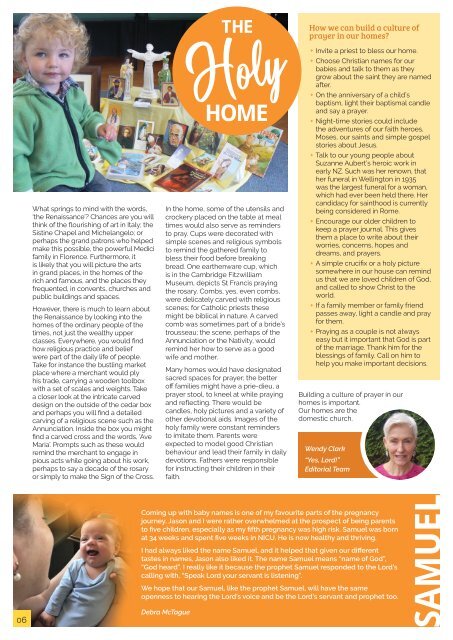"Yes Lord!" (March 2019)
A magazine of St Francis of Assisi Parish in Mairehau Christchurch New Zealand
A magazine of St Francis of Assisi Parish in Mairehau Christchurch New Zealand
You also want an ePaper? Increase the reach of your titles
YUMPU automatically turns print PDFs into web optimized ePapers that Google loves.
What springs to mind with the words,<br />
‘the Renaissance’? Chances are you will<br />
think of the flourishing of art in Italy; the<br />
Sistine Chapel and Michelangelo; or<br />
perhaps the grand patrons who helped<br />
make this possible, the powerful Medici<br />
family in Florence. Furthermore, it<br />
is likely that you will picture the arts<br />
in grand places, in the homes of the<br />
rich and famous, and the places they<br />
frequented, in convents, churches and<br />
public buildings and spaces.<br />
However, there is much to learn about<br />
the Renaissance by looking into the<br />
homes of the ordinary people of the<br />
times, not just the wealthy upper<br />
classes. Everywhere, you would find<br />
how religious practice and belief<br />
were part of the daily life of people.<br />
Take for instance the bustling market<br />
place where a merchant would ply<br />
his trade, carrying a wooden toolbox<br />
with a set of scales and weights. Take<br />
a closer look at the intricate carved<br />
design on the outside of the cedar box<br />
and perhaps you will find a detailed<br />
carving of a religious scene such as the<br />
Annunciation. Inside the box you might<br />
find a carved cross and the words, ‘Ave<br />
Maria’. Prompts such as these would<br />
remind the merchant to engage in<br />
pious acts while going about his work,<br />
perhaps to say a decade of the rosary<br />
or simply to make the Sign of the Cross.<br />
In the home, some of the utensils and<br />
crockery placed on the table at meal<br />
times would also serve as reminders<br />
to pray. Cups were decorated with<br />
simple scenes and religious symbols<br />
to remind the gathered family to<br />
bless their food before breaking<br />
bread. One earthenware cup, which<br />
is in the Cambridge Fitzwilliam<br />
Museum, depicts St Francis praying<br />
the rosary. Combs, yes, even combs,<br />
were delicately carved with religious<br />
scenes; for Catholic priests these<br />
might be biblical in nature. A carved<br />
comb was sometimes part of a bride’s<br />
trousseau; the scene, perhaps of the<br />
Annunciation or the Nativity, would<br />
remind her how to serve as a good<br />
wife and mother.<br />
Many homes would have designated<br />
sacred spaces for prayer; the better<br />
off families might have a prie-dieu, a<br />
prayer stool, to kneel at while praying<br />
and reflecting. There would be<br />
candles, holy pictures and a variety of<br />
other devotional aids. Images of the<br />
holy family were constant reminders<br />
to imitate them. Parents were<br />
expected to model good Christian<br />
behaviour and lead their family in daily<br />
devotions. Fathers were responsible<br />
for instructing their children in their<br />
faith.<br />
How we can build a culture of<br />
prayer in our homes?<br />
+ + Invite a priest to bless our home.<br />
+ + Choose Christian names for our<br />
babies and talk to them as they<br />
grow about the saint they are named<br />
after.<br />
+ + On the anniversary of a child’s<br />
baptism, light their baptismal candle<br />
and say a prayer.<br />
+ + Night-time stories could include<br />
the adventures of our faith heroes,<br />
Moses, our saints and simple gospel<br />
stories about Jesus.<br />
+ + Talk to our young people about<br />
Suzanne Aubert’s heroic work in<br />
early NZ. Such was her renown, that<br />
her funeral in Wellington in 1935<br />
was the largest funeral for a woman,<br />
which had ever been held there. Her<br />
candidacy for sainthood is currently<br />
being considered in Rome.<br />
+ + Encourage our older children to<br />
keep a prayer journal. This gives<br />
them a place to write about their<br />
worries, concerns, hopes and<br />
dreams, and prayers.<br />
+ + A simple crucifix or a holy picture<br />
somewhere in our house can remind<br />
us that we are loved children of God,<br />
and called to show Christ to the<br />
world.<br />
+ + If a family member or family friend<br />
passes away, light a candle and pray<br />
for them.<br />
+ + Praying as a couple is not always<br />
easy but it important that God is part<br />
of the marriage. Thank him for the<br />
blessings of family. Call on him to<br />
help you make important decisions.<br />
Building a culture of prayer in our<br />
homes is important.<br />
Our homes are the<br />
domestic church.<br />
Wendy Clark<br />
“<strong>Yes</strong>, <strong>Lord</strong>!”<br />
Editorial Team<br />
Coming up with baby names is one of my favourite parts of the pregnancy<br />
journey. Jason and I were rather overwhelmed at the prospect of being parents<br />
to five children, especially as my fifth pregnancy was high risk. Samuel was born<br />
at 34 weeks and spent five weeks in NICU. He is now healthy and thriving.<br />
I had always liked the name Samuel, and it helped that given our different<br />
tastes in names, Jason also liked it. The name Samuel means “name of God”,<br />
“God heard”. I really like it because the prophet Samuel responded to the <strong>Lord</strong>’s<br />
calling with, “Speak <strong>Lord</strong> your servant is listening”.<br />
We hope that our Samuel, like the prophet Samuel, will have the same<br />
openness to hearing the <strong>Lord</strong>’s voice and be the <strong>Lord</strong>’s servant and prophet too.<br />
06<br />
Debra McTague





